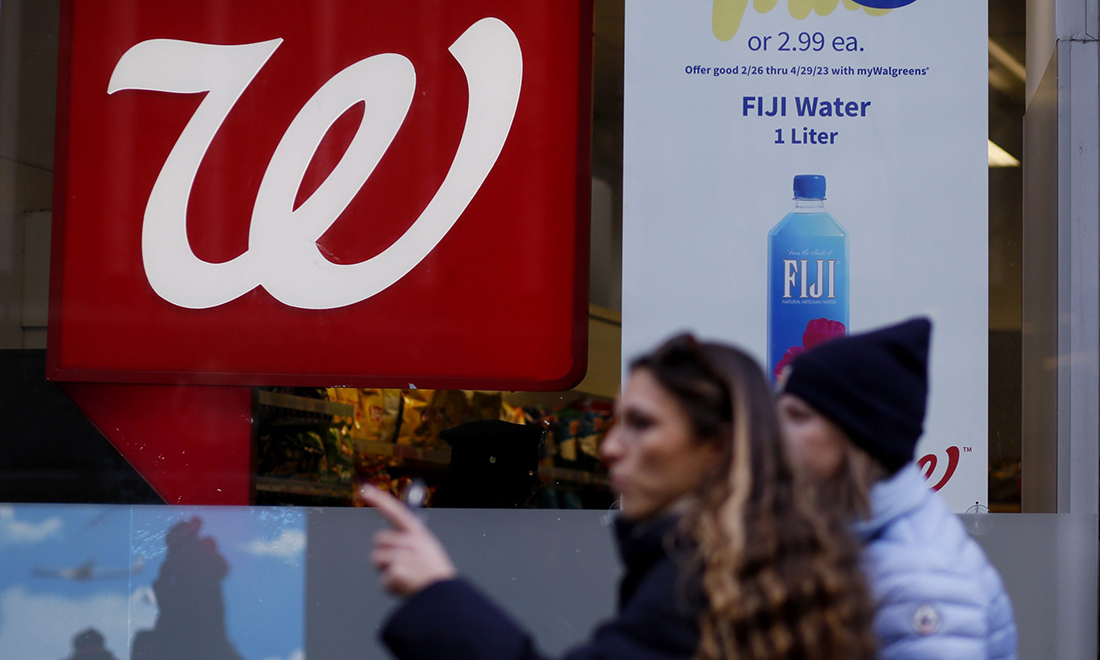
連鎖藥店沃爾格林上周四公布了好于預期的收益,但分析師對其能否從幾年來新冠疫苗和治療需求下降以及零售競爭加劇的挑戰中恢復過來并不抱信心。
沃爾格林的收益超出預期,銷售額同比增長6.3%,達到371億美元,每股收益增長3.4%,達到1.20美元。但報告的其余部分卻顯示出這家公司的脆弱性:該公司報告了132億美元的運營虧損,其中124億美元是非現金減值支出,或與初級保健提供商VillageMD有關的注銷。VillageMD計劃關閉160家不盈利的門店。這些虧損促使GlobalData董事總經理尼爾·桑德斯(Neil Saunders)將本財報期稱為“又一個令人不安的季度”。
桑德斯在上周四的一份報告中寫道:“雖然這些都是技術性調整,但卻凸顯了沃爾格林過去幾年做出的糟糕戰略決策,以及其在醫療保健領域的種種錯誤行為。在新任首席執行官的領導下,沃爾格林堅定不移地將業務重心放在提高盈利能力上,而且被迫從過去被視為未來核心的業務中后退一大步。”
沃爾格林預計會遭遇挫折,特別是2月份出售藥品批發公司Cencora價值9.92億美元的股票會對收益造成打擊,這促使該公司將全年調整后每股收益的上限從3.50美元下調至3.35美元。該公司希望在全年節省10億美元。去年10月,在員工因工作條件惡劣而罷工的動蕩時期后,沃爾格林首席執行官蒂姆·溫特沃斯(Tim Wentworth)接任。他轉而將沃爾格林未來面臨的挑戰歸咎于零售業務,該業務因消費者不愿購買非必需品而陷入困境。
由于通貨膨脹和藥品成本上升,沃爾格林醫藥業務的銷售額增長了4.7%,但零售業務的總銷售額下降了4.5%。德勤(Deloitte)3月份的《消費者信號》報告顯示,可自由支配支出意愿仍低于總體支出意愿,自疫情復蘇以來,總體支出意愿一直起伏不定。
溫特沃斯上周四在接受彭博電視臺采訪時表示:“我們指望人們不僅光顧藥店,而且會因一時沖動購買商品,在緊急關頭購買商品,或是購買季節性商品。客戶必須覺得這些商品中的很多都物超所值,否則就會覺得它們可買可不買。”
其競爭對手CVS也面臨著類似的困境。去年秋天,在藥價上漲和對新冠相關治療需求減少導致門店客流量放緩后,該公司也宣布縮減初級保健計劃。另一家連鎖藥店Rite Aid也關閉了1500家門店,落入破產的境地。此外,呼吸道疾病的淡季意味著購買紙巾和非處方藥的人減少了。
改變零售策略
毋庸置疑的是,沃爾格林采取了更大的舉措來吸引資金緊張的客戶。沃爾格林的一位發言人告訴《財富》雜志,該連鎖店“通過對關鍵價值商品進行投資,并專注于以極其有針對性的方式與客戶互動,來應對這些市場動態。”沃爾格林上個季度推出了37種新款自有品牌產品,并正在利用庫存單位合理化來確定哪些產品對消費者更有吸引力。
桑德斯說,雖然客戶在沃爾格林購買一般商品是出于方便,但他們也會去其他商店購買便宜商品。沃爾格林在美容領域尤其吃虧,因為消費者愿意花更多的錢,但如今這些客戶卻轉向塔吉特(Target)和Ulta等競爭對手,后者提供更多的選擇,而且價格更低。桑德斯斷言,沃爾格林在零售銷售方面落后并不是因為購物者不愿花錢。沃爾格林之所以虧損,是因為消費者去其他商店尋找更物美價廉的產品。
他說:“從根本上說,沃爾格林之所以虧損,是因為它不擅長零售。”
但溫特沃斯強調了沃爾格林實體店的重要性,他在周四表示,沃爾格林的客戶服務將它與亞馬遜(Amazon)等電子商務巨頭區別開來。
他對美國全國廣播公司財經頻道(CNBC)說:“我們將擊敗亞馬遜,因為我們在社區和街區提供人性化服務。”
不過,桑德斯告訴《財富》雜志,沃爾格林并不以客戶服務著稱,由于客戶經常光顧沃爾格林是出于方便,他們往往并不需要高水平的幫助。
桑德斯說:“沃爾格林認為這是該連鎖店的優勢領域,但這只是一廂情愿。”(財富中文網)
譯者:中慧言-王芳
連鎖藥店沃爾格林上周四公布了好于預期的收益,但分析師對其能否從幾年來新冠疫苗和治療需求下降以及零售競爭加劇的挑戰中恢復過來并不抱信心。
沃爾格林的收益超出預期,銷售額同比增長6.3%,達到371億美元,每股收益增長3.4%,達到1.20美元。但報告的其余部分卻顯示出這家公司的脆弱性:該公司報告了132億美元的運營虧損,其中124億美元是非現金減值支出,或與初級保健提供商VillageMD有關的注銷。VillageMD計劃關閉160家不盈利的門店。這些虧損促使GlobalData董事總經理尼爾·桑德斯(Neil Saunders)將本財報期稱為“又一個令人不安的季度”。
桑德斯在上周四的一份報告中寫道:“雖然這些都是技術性調整,但卻凸顯了沃爾格林過去幾年做出的糟糕戰略決策,以及其在醫療保健領域的種種錯誤行為。在新任首席執行官的領導下,沃爾格林堅定不移地將業務重心放在提高盈利能力上,而且被迫從過去被視為未來核心的業務中后退一大步。”
沃爾格林預計會遭遇挫折,特別是2月份出售藥品批發公司Cencora價值9.92億美元的股票會對收益造成打擊,這促使該公司將全年調整后每股收益的上限從3.50美元下調至3.35美元。該公司希望在全年節省10億美元。去年10月,在員工因工作條件惡劣而罷工的動蕩時期后,沃爾格林首席執行官蒂姆·溫特沃斯(Tim Wentworth)接任。他轉而將沃爾格林未來面臨的挑戰歸咎于零售業務,該業務因消費者不愿購買非必需品而陷入困境。
由于通貨膨脹和藥品成本上升,沃爾格林醫藥業務的銷售額增長了4.7%,但零售業務的總銷售額下降了4.5%。德勤(Deloitte)3月份的《消費者信號》報告顯示,可自由支配支出意愿仍低于總體支出意愿,自疫情復蘇以來,總體支出意愿一直起伏不定。
溫特沃斯上周四在接受彭博電視臺采訪時表示:“我們指望人們不僅光顧藥店,而且會因一時沖動購買商品,在緊急關頭購買商品,或是購買季節性商品。客戶必須覺得這些商品中的很多都物超所值,否則就會覺得它們可買可不買。”
其競爭對手CVS也面臨著類似的困境。去年秋天,在藥價上漲和對新冠相關治療需求減少導致門店客流量放緩后,該公司也宣布縮減初級保健計劃。另一家連鎖藥店Rite Aid也關閉了1500家門店,落入破產的境地。此外,呼吸道疾病的淡季意味著購買紙巾和非處方藥的人減少了。
改變零售策略
毋庸置疑的是,沃爾格林采取了更大的舉措來吸引資金緊張的客戶。沃爾格林的一位發言人告訴《財富》雜志,該連鎖店“通過對關鍵價值商品進行投資,并專注于以極其有針對性的方式與客戶互動,來應對這些市場動態。”沃爾格林上個季度推出了37種新款自有品牌產品,并正在利用庫存單位合理化來確定哪些產品對消費者更有吸引力。
桑德斯說,雖然客戶在沃爾格林購買一般商品是出于方便,但他們也會去其他商店購買便宜商品。沃爾格林在美容領域尤其吃虧,因為消費者愿意花更多的錢,但如今這些客戶卻轉向塔吉特(Target)和Ulta等競爭對手,后者提供更多的選擇,而且價格更低。桑德斯斷言,沃爾格林在零售銷售方面落后并不是因為購物者不愿花錢。沃爾格林之所以虧損,是因為消費者去其他商店尋找更物美價廉的產品。
他說:“從根本上說,沃爾格林之所以虧損,是因為它不擅長零售。”
但溫特沃斯強調了沃爾格林實體店的重要性,他在周四表示,沃爾格林的客戶服務將它與亞馬遜(Amazon)等電子商務巨頭區別開來。
他對美國全國廣播公司財經頻道(CNBC)說:“我們將擊敗亞馬遜,因為我們在社區和街區提供人性化服務。”
不過,桑德斯告訴《財富》雜志,沃爾格林并不以客戶服務著稱,由于客戶經常光顧沃爾格林是出于方便,他們往往并不需要高水平的幫助。
桑德斯說:“沃爾格林認為這是該連鎖店的優勢領域,但這只是一廂情愿。”(財富中文網)
譯者:中慧言-王芳
Pharmacy chain Walgreens posted better-than-expected earnings on Thursday, but analysts are not confident in its ability to recover from a challenging few years of decreasing demand for COVID vaccines and treatments and increased retail competition.
Walgreens beat earnings estimates, posting a 6.3% sales leap year over year to $37.1 billion, as well as a 3.4% earnings per share bump of $1.20. But the rest of the report tells the story of a more fragile company: It reported a $13.2 billion operating loss—$12.4 billion of which was a noncash impairment charge, or write-off related to its primary care provider, VillageMD, which plans to shut down 160 unprofitable locations. The losses prompted Neil Saunders, managing director of GlobalData, to call the earnings period “another torrid quarter.”
“While these things are technical adjustments, they underline the poor strategic decisions Walgreens has made over the past few years and its various misadventures in health care,” Saunders wrote in a Thursday note. “With the focus of the business firmly on driving profitability under a new CEO, Walgreens has had to take a very big step back from operations that it used to see as central to its future.”
Walgreens anticipated some of its struggles, particularly including an earnings hit from its February sale of $992 million in shares of wholesale drug company Cencora, which pushed the company to lower the top end of its full-year adjusted earnings per share from $3.50 to $3.35. The company hopes to save $1 billion over the course of the year. CEO Tim Wentworth—who took Walgreens’ helm last October after a tumultuous period of staff walkouts over poor working conditions—instead attributes Walgreens’ future challenges to the retail side of the business, which has struggled because of consumers’ unwillingness to buy discretionary items.
Walgreens reported 4.7% sales growth on the pharmaceutical side of the business owing to rising inflation and drug costs, but a 4.5% total sales decline on the retail side. Deloitte’s March ConsumerSignals report indicates that discretionary spending intentions are still below overall spending intentions, which have ebbed and flowed since recovery from the pandemic.
“We count on folks to come in and to not only visit our pharmacies, but come in, buy impulse items, get last-minute items, get seasonal items,” Wentworth told Bloomberg TV on Thursday. “A lot of those things are purchases that you have to get the value equation right on or else they feel discretionary to folks.”
Competitor CVS is having similar struggles. It, too, announced scale backs on primary care initiatives last fall after rising drug prices and a lessened demand for pandemic treatments slowed store traffic. Bankrupt Rite Aid, another drugstore chain, also closed a combined 1,500 stores. Plus, a weak respiratory illness season meant fewer people were buying tissues and over-the-counter medicine.
Retail strategy changes
To be sure, Walgreens has taken bigger swings to attract cash-strapped customers. A Walgreens spokesperson told Fortune that the chain is “responding to these market dynamics by making investments in key value items, and focusing our capabilities to engage with customers in a very targeted way.” Walgreens introduced 37 new store-brand products last quarter and is using stockkeeping unit rationalization to determine which products are more appealing to consumers.
While customers are buying general merchandise at Walgreens for convenience, they are going elsewhere to find bargains, Saunders said. Walgreens has particularly been losing out in the beauty sector, where customers are willing to spend more money, but are turning to competitors like Target and Ulta, which offer larger selections and lower prices. Walgreens isn’t lagging in retail sales because of shoppers unwilling to spend money, Saunders asserted. It is losing money because consumers are going elsewhere for better deals and products.
“Basically, Walgreens is losing out because it is just not very good at retailing,” he said.
But Wentworth doubled down on the importance of brick-and-mortar Walgreens, saying on Thursday that its customer service is what separates it from e-commerce giants like Amazon.
“We will beat Amazon because of the human interface that we offer in communities and neighborhoods,” he told CNBC.
Saunders told Fortune, however, that Walgreens is not known for its customer service, and because customers frequent Walgreens out of convenience, they often don’t require high levels of help.
“Walgreens’ view that this is an area of strength for the chain is a case of wishful thinking,” Saunders said.






